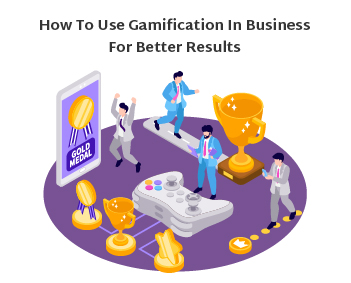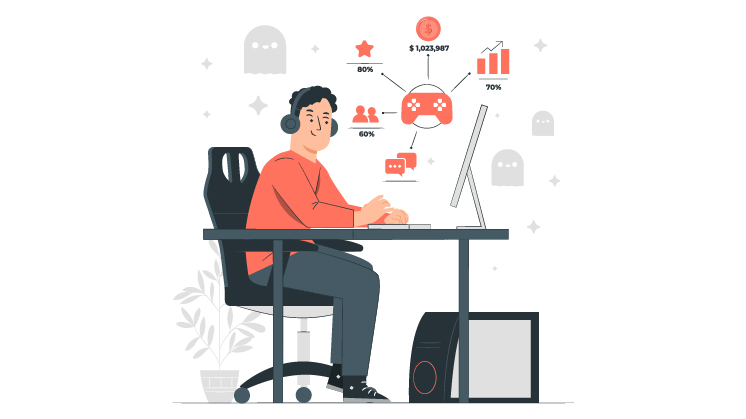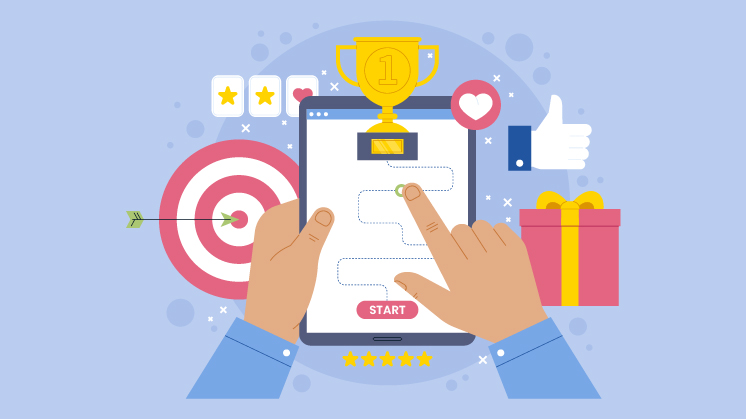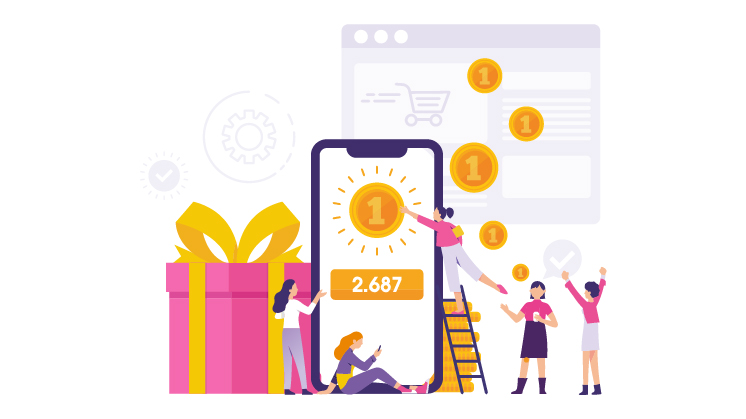If your employees are experiencing boredom, you have a powerful tool at your disposal, i.e., gamification. Studies show that when companies employ gamification in business, productivity soars—up to 90 percent. Inculcate game mechanics into your staff’s daily routine, as excitement at work boosts motivation and productivity. Happy employees drive revenue and KPIs.
Read this blog and discover how gamification in business can supercharge productivity and elevate the customer experience.
Gamification in Business – Making Work a Game
In the contemporary world, where tasks feel repetitive and uninspiring, gamification allows you to enjoy and engage. It’s the art of transforming mundane tasks into engaging games, injecting a dose of excitement into the daily grind.
Imagine employees racing to complete tasks, earning points and badges as they go, and their progress proudly displayed on leaderboards. Visualize customers eagerly participating in interactive challenges, their loyalty rewarded with discounts and special offers. This is the power of gamification.
The benefits of gamification extend far beyond mere entertainment. Studies have shown that gamified environments can boost employee productivity, increase customer engagement, and enhance brand loyalty.
A study by Zippia predicts that the gamification market will surpass $30.7 billion by 2025, driven by the widespread adoption of mobile devices in the workplace.
So, how do you gamify your business?
The possibilities are endless. Rewards, competitions, leaderboards, and even actual games can seamlessly integrate into your operations. Let’s explore some examples.
Rewarding Achievements
Acknowledge and appreciate employee accomplishments with a points system. Each completed task or achieved milestone earns points that can be redeemed for rewards, such as gift cards, extra vacation days, or even recognition in company newsletters.
Sparking Competition
Ignite the spirit of friendly rivalry by hosting competitions among employees. You can set goals for specific tasks or departments. Or you can reward the top performers with prizes or bragging rights. Leaderboards can add to the excitement, displaying individual and team progress.
Gamification in Business – Diving Deep
The gamification industry has explosive growth, expanding at a rate of 27.4% annually. This upward trend is driven largely by recognizing that game techniques better engage and motivate employees.
What does this gamification boom mean for your business? Simply put, you need to adopt gamification or risk getting left behind.
Your competitors are already using gamification to create more enjoyable and engaging workplaces. This indirectly leads to better customer experiences as happier employees provide superior service.
If you don’t implement game mechanics, it will be tough for you to attract top talent. Also, customer satisfaction may suffer compared to gamified rivals.
The data shows that almost every business should implement gamification for benefits like:
- Increased productivity from engaged staff
- Improved employee satisfaction and user engagement
- Better training and skill-building
- Positive brand association with customers
Use gamification techniques to future-proof your business. Gamification in business is the best way to motivate employees, excite customers, and improve key metrics with game thinking.
3 Reasons Why You Should Use Gamification in Business
Listed below are some reasons for incorporating gamification in business that can benefit both your employees and potential clients:
1- Gamification Enhances Success Ratio of Hiring Programs
It’s staggering that as many as 60 percent of companies fail to set attainable milestones for employee onboarding. Without clear goals and objectives, new employees are essentially set up for failure.
How can you possibly know how your new hires are progressing, adapting to their new roles, and absorbing training without establishing targets and following up regularly?
- Gamification in business for employee training and onboarding can be a powerful tool to address this issue. By incorporating game-like elements into the onboarding process, you can increase employee engagement and retention and ensure they receive the training to meet your expectations.
- Consider the customer journey as well. How do you attract potential customers and guide them through learning about your business and eventually becoming loyal patrons?
- Gamification can also be applied to the customer onboarding process, providing them with a platform to share their experiences, achievements, and milestones along the way.
By incorporating gamification into employee and customer onboarding, you can create a more engaging, interactive, and rewarding experience. This can increase employee satisfaction, reduce turnover, and improve customer loyalty.
2- Improves Efficiency and Work Speed
Every business owner desires quick and precise work from their employees. The key to achieving this goal is “efficiency.” By incorporating elements of games into routine tasks, the workday becomes more enjoyable and leads to increased productivity.
When employees are actively engaged in their work, the likelihood of them finishing tasks on schedule significantly improves.
3- Boosts Employees’ Morale
Around 64% of employees in the U.S. are not engaged at work.
It suggests they lack interest and enthusiasm in their tasks. Often, it’s not their fault, as management and corporate culture play a significant role. As a business owner, you must create a positive environment. If your employees lack engagement, it’s essential to take action.
Gamification in business offers a straightforward solution. By incorporating game-like elements into daily tasks, you can make work more engaging and enjoyable, boosting employee interest and productivity.
Gamification in Business – Which Businesses Should Implement Gamification
It’s important to recognize that gamification is a tool accessible to various business types. If your business aligns with one of the following four categories, you must consider implementing gamification techniques and strategies.
Gamification in Healthcare
The healthcare industry is always surrounded by immense stress. Medical burnout troubles over half of the industry. Mental and physical exhaustion takes a heavy toll. Here, gamification can provide a powerful antidote to burnout.
Fun challenges, rewards, and breaks make stressful days more engaging. Even simple well-being apps reenergize staff through gameplay.
Healthcare organizations must prioritize worker wellness and retention. Gamification elements like leaderboards give personnel something positive to anticipate despite nonstop demands. Whether points for steps, virtual patients cured, or relaxing break time quests, introducing game mechanics usher healthcare workplaces and uplift employees.
Gamification in the Retail Sector
The retail sector can often be a high-pressure environment. While the primary focus of many retail businesses is customer satisfaction, executives must consider the well-being of their employees.
Individuals working in this industry could greatly benefit from the introduction of gamified loyalty rewards point systems, which are based on customer service and sales performance. This approach is equally effective for customers.
Programs for loyalty rewards that pay customers back for their loyalty are quite popular in this industry.
Food Industry
Fast-food restaurants are often bustling environments where employees work diligently to fulfill orders. Focusing on supply chain execution can improve operational flow by improving visibility and ensuring timely deliveries, which ultimately boosts efficiency and reduces costs.
Introducing gamification in the food service business, like order-taking and food delivery, can streamline work processes and enhance job satisfaction.
While this approach directly benefits the customer, incorporating additional gamification elements can further enhance the experience. Many fast-food establishments now offer apps that allow customers to order their meals before they arrive at the drive-thru window, simplifying the process for both customers and employees.
How To Implement Gamification in Business
Let’s learn about some specific ways to use gamification in business. Following are the popular and effective methods that help you engage and entertain your clients while keeping your employees motivated.
1- Points or Reward Systems
It’s a well-known fact that employee recognition plays a significant role in motivating good performance. In most cases, employees are genuinely inclined to excel in their roles, but their motivation can wane if they don’t perceive the impact of their efforts.
One effective method to acknowledge and motivate employees is by implementing reward and recognition systems, such as gamification.
Integrating gamification elements into everyday achievements involves enabling employees to accrue points that can be exchanged for a variety of perks, including company merchandise, extended break times, complimentary snacks, celebratory pizza gatherings, and even additional time off.
Points and rewards can also be effectively employed from a customer perspective. Implementing a customer loyalty program, for example, can be an excellent strategy to cultivate repeat business.
Consider using a WordPress gamification plugin that tallies points for each customer purchase. It will allow them to redeem them for complimentary items and merchandise, improving customer loyalty.
Leaderboards
Competition fuels humans. While opinions on this matter may vary among individuals, it holds particularly true in specific business contexts, with sales being a prime example. For instance, in the case of a car dealership, employing a digital scoreboard can serve as a valuable tool to assess competition and evaluate the performance of different sales representatives.
Consider a non-profit organization. Imagine the organization’s objective is to plant one hundred trees within a designated metropolitan area.
In this scenario, gamification in business can be a significant motivating factor for all the supporters contributing to this cause. Each time an individual participates in planting a tree, they earn the privilege of having another tree associated with their name.
Digital leaderboards can also help to showcase those employees who have earned the most favorable customer feedback. An alternative approach is a virtual bucket, which offers a unique take on the traditional leaderboard concept.
The virtual bucket accumulates as employees receive positive feedback, with the volume of accumulation corresponding to the feedback’s level of positivity. That means:
- Mildly positive feedback results in a modest increase in the bucket’s content.
- Exceptionally positive feedback leads to a substantial increase.
Wrap Up
Gamifying mundane activities improves the quality of life for employees who give so much. Implementing gamification in business boosts productivity and employee engagement. Every owner wants happy, fulfilled staff. You can integrate game mechanics into all aspects, including hiring, training, and goal setting.





